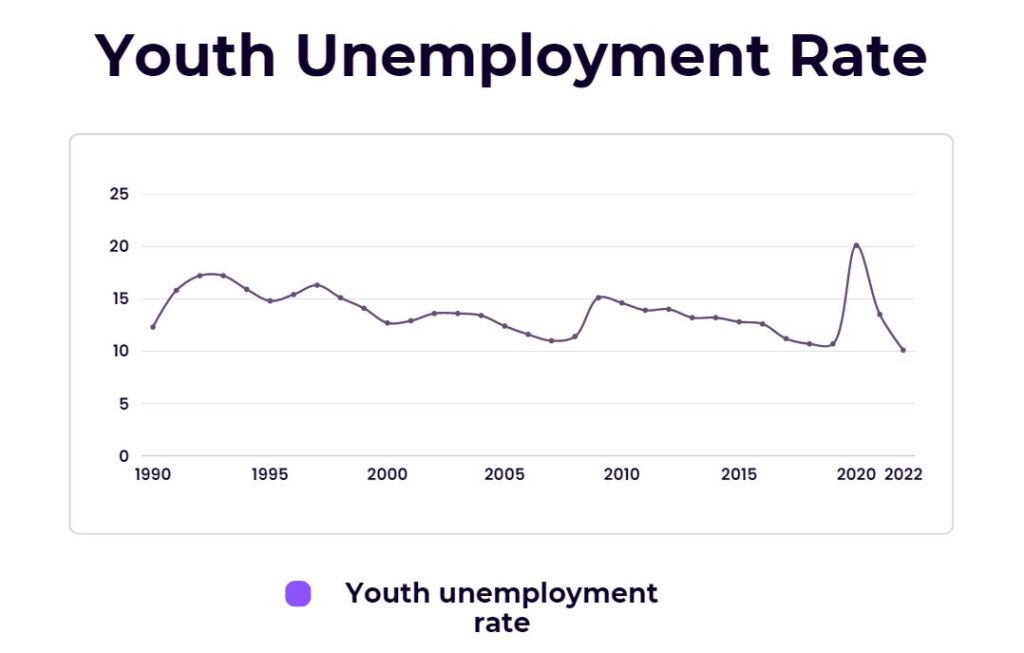
Listen to the story here:
The latest labour force data for February shows that the youth unemployment rate continues to remain well below the average for the last 40 years.
The unemployment rate for youth aged 15-24 rose slightly to 9.9 per cent in February from 9.5 per cent in January, according to Statistics Canada. But that is still significantly lower than historic rates.
The youth unemployment rate in Canada averaged 13.9 per cent from 1976 until 2023, reaching an all-time high of about 28 per cent in May 2020, near the beginning of the pandemic. It dropped to a record low of 9.2 per cent in June 2022 and then rose to 10.6 per cent in October before heading down again in recent months.

Unemployment for all age groups has been steady over the past two months at 5 per cent.
“COVID-19 has completely changed how the labour market has operated,” said Aloysius Siow, an economics professor at the University of Toronto. Youth are more flexible and able to adapt to new technologies like working primarily from home, a process that COVID-19 accelerated for all and that means today’s youth have many choices, he said.
“The young people who are entering the job market right now, I would say that the advantage is enormous.”
With more options, youth today can be more selective when evaluating positions about things like pay, benefits or working from home, said Wincy Li, associate director of the Career, Co-op & Student Success Centre at TMU, which supports students’ job searches and connects them with employers.
Kristina Kisin is a politics and governance fourth-year student who used the Career Centre to find opportunities like university placements, campus jobs, and summer internships.
Currently, she works three part-time jobs. She said with part-time work, she can take advantage of what hours she works and when she’s available.
Siow said he sees more youth leaning towards part-time and contract work because of the desire for flexibility that it offers students. He said despite overall improvement in youth employment numbers, the work isn’t always secure or permanent, with most students and youth only having access to part-time or contract work.
In Ontario, there were 530,000 young people with part-time employment (less than 30 hours per week) in February. Of that, about 414,000 worked part-time because they were in school.
Kisin said after gaining relevant experience from working contract and part-time work for six years during school, she hopes to find full-time work soon after she graduates this spring.
For others, the job search hasn’t been as successful. Seventeen-year-old Zahra Bhiwandiwala said she has been looking for a part-time minimum wage job since December. The high school student said she’s applied to more than 50 jobs.
Li said youth employment encompasses many types of jobs across many industries and that means the unemployment rate can vary depending on a multitude of factors like education or industry.
“Youth unemployment rate is only a statistic and an individual’s experience in the labour market may align with what that statistic implies, or not,” said Li.
When students are having a tough time with job searching, Li said students should look at labour market trends, consult with mentors and seek informational interviews with industry professionals to better understand the job market.
Bhiwandiwala said as a visible Muslim finding employment was harder.
“I felt like a minority in some places that I was applying to. If I had an interview on the phone and it went great but then, the employer would ask me what ethnicity I was, and when I told him, he immediately told me he was looking for another candidate.”
In its January labour force report, Statistics Canada said higher unemployment levels persist for many racialized groups. Amongst people aged 25 to 54, the highest unemployment rate was among Arab Canadians at 8.1 per cent and Korean Canadians at 8 per cent. The rate was 7.2 per cent for Black Canadians and 5.8 per cent for people of West Asian origin. Data specific for racialized youth was not provided.
Elena De Luigi has also had trouble finding employment in her industry. She completed her Masters in journalism at TMU in 2022 and said she had trouble finding full-time, permanent employment since she graduated.
The 26-year-old has been working two part-time jobs as a teaching assistant in the meantime to make ends meet.
She said the job-hunting process itself is overwhelming and tedious.
“It’s a full-time job in itself.”
To help with her search, De Luigi joined Monday Girl, a career mentoring platform for women and marginalized genders. As a queer woman, De Luigi said the support and networking space helped her through her unemployment time.
After months of applying to over 50 job openings, De Luigi was offered a full-time, permanent position at the end of February.
